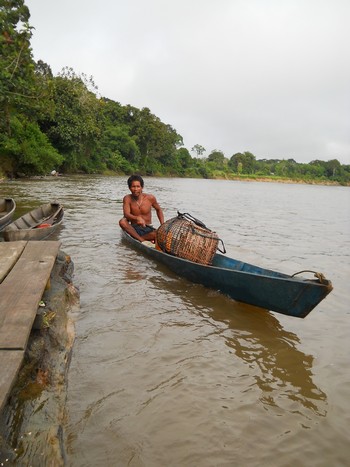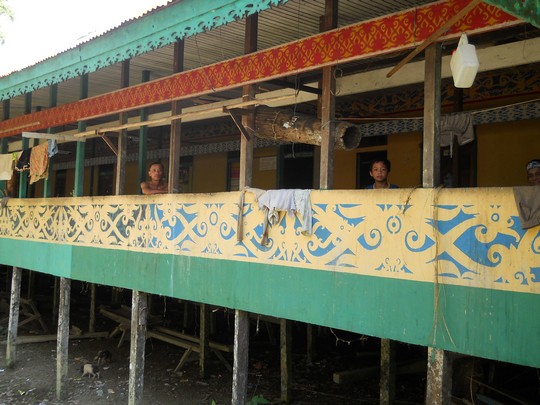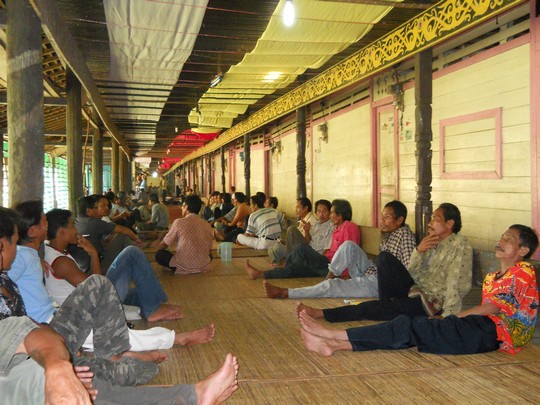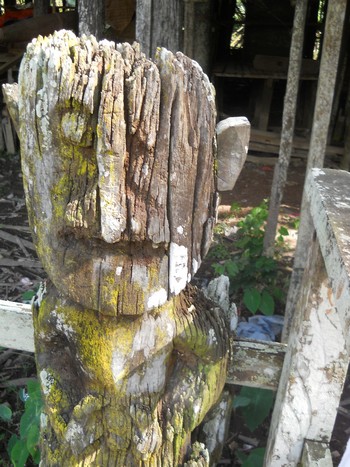Taman Dayaks owe their existence to carefully nurtured resources, but they have to adapt if they want to survive
Johan Weintré
The roosters were crowing before darkness had faded in the riverside Dayak hamlet of Kunsali Patamuan in Kapuas Hulu district, West Kalimantan. Through the cracks of the timber walls in the 122 metre wide longhouse, the faint sound of shuffling feet on squeaky floors penetrated to the compartments, as people went back and forth to the kitchens at the back of each living quarter. Not long afterwards, the clattering of tin kettles and stirring of teaspoons could be heard right, left and centre. The longhouse was awakening.
The village of Malapi is one of the home villages of the Tamans, a sub group of the Iban Dayak. There are about 6000 Tamans in all, their community spread through about a dozen villages in Kapuas Hulu. The village of Malapi is one of them, and consists of a string of four hamlets, one of which is Kunsali Patamuan, and six longhouses. Each longhouse lodges between 20 and 40 family units. All are close to the river which runs through the village.
Our particular longhouse was only recently relocated here as the ever-moving Kapuas river bed had turned its erosive powers right up to the front of the old longhouse. The old site had to be abandoned. An increasing rate of riverbank erosion is one of the environmental problems facing this community as a result of upstream logging, both legal and illegal.
Every family living in the old longhouse builds their own compartment or bilik, and it might take ten years or more before all are completed. The wood used in the structure can be newly cut timber from the surrounding village forest; it can be purchased from outside the village, or salvaged from the old longhouse.
Incorrectly obtained timber
In 2008 a longhouse ritual was performed by the most revered shaman (balien) from the hamlet of Patamuan, which has the oldest longhouse in the village. The ritual aimed not only to spare residents and structures from evil spirits and bad fortune. It was also intended to ask for special clemency from the spirits, as some of the materials used might have been incorrectly obtained.
These timbers, cut by non-Tamans, might not have been collected in a way that observed the complex code of proscriptions (pantang) of the Tamans, who are very cognisant of omens and natural signs when they collect wood and other natural material. They are particularly guided by, for example, certain bird sounds or the direction of bird flight, which helps them to ascertain the worthiness of the material to be incorporated in the construction. A special ritual, which takes place over several days and involves the offering of boars, cows and special sweets, is held to request the forgiveness of the spirits.
 |
|
Travelling from the longhouse to the rice fields on the other side of the river / Johan Weintré |
One legend tells us that the Tamans on the Kapuas River settled on the alluvial soils close to the river from their initial upstream location at the source of this river many generations ago. Their current position is not far away from the mountainous territories of the Punan Dayaks who are strangers to rice cultivation. In contrast, the Taman Dayaks are long-established rice growers.
Traditionally, the people of every longhouse would grow up to 20 rice varieties, indicating that they are aware of the need for a diverse gene pool for their staple food. The Tamans have also planted a government-introduced high yielding rice variety, but it seems unable to compete well with the local varieties. It lacks the genetic resistance to local diseases and pests that the local seeds have apparently developed.
Privately-held family rice fields are freely lent out to the needy in the community so the less fortunate, too, can be self-sufficient in rice production. No monetary or crop-sharing arrangements are expected when such loans occur. This is one indication of the strong custodian relationship the Tamans have with their land: they do not see themselves as being in a purely ownership relation with their rice fields and their environment.
As well as growing rice, the Tamans also hunt the surrounding lowlands for wild deer, boars, snakes and large lizards and pick different types of fruits, ferns and leaves from the forest to give their meals better flavour and variation. Due to their location on the plains, they are also able to fish in the rivers or in the nearby lakes formed by old river beds.
Crocodiles are a thing of the past
River crocodiles were once plentiful, but have been almost hunted out, making the main river safe for bathing. In the past, the Tamans also needed to fence off their shifting rice fields in the forest to protect them from foraging hoofed animals and bands of roaming monkeys. But times have changed. A decade or two ago, wildlife numbers – especially the much prized wild boars – had dwindled to such an extent that it became possible to grow rice in unfenced fields.
The Tamans usually build simple but comfortable high stilted huts in their fields and stay there for months on end during the rice planting and harvesting seasons, or whenever they want to enjoy quiet time away from the longhouse. Their presence also discourages the remaining foraging wildlife and prevents any possible human pilferage of the valuable rubber or bananas which they sell at the market in Putussibau.
The Kapuas Taman Dayaks owe their existence to the natural resources which are contained in the river watershed. This watershed happens to be part of the longest river in Indonesia, the Kapuas, which meanders for more than a thousand kilometres through West Kalimantan.
 |
|
Many families live in a single longhouse / Johan Weintré |
For some, the riches in the river system are quite literal: it contains alluvial gold. However, the pressure of the cash economy, driven by expensive fuel, outboard motors, education, motorbikes, mobile phones among many other expenses, has forced many upstream Dayaks to abandon their traditional and low-impact methods of gold panning. Now, when the Dayaks on the Upper Kapuas River strike it rich they might invest in dredging equipment in order to pull out more gold from riverbeds, or in land-based high pressure water soil blasting endeavours.
Not only Tamans are involved in the search for gold. Gold attracts members of outside communities too. Some of them use mercury to extract even the finest particles of gold and turn them into small gold nuggets for easy trade. Using mercury in this way is controversial, because it has well-known detrimental effects on the health of the gold miners themselves and on water quality further downstream.
Changes in fishing methods
The Dayak have a long history of involvement with the river and its fish. Spearing fish or catching them with bamboo traps, nets made from natural fibres, or hooks and lines was a sustainable and uncomplicated way for any riverside community in the upper Kapuas region to feed itself. Since those early days of artisan fishing, many changes have taken place. The introduction of nylon fibres to make fishing nets in the 1970s and of factory-made complete fishing nets in the 1980s increased catches many times over, reducing the fish stock in the river. Some people also use portable 220 volt electricity generators to electrocute fish. This practice has not only taken a further toll on fish stocks but has also caused the deaths of some fishers. Most villages along the river, including the Taman village of Malapi, have realised that such practices are unsustainable and dangerous and have therefore introduced adat fines to ban them.
The severity of overfishing and near extinction of several species has put the people’s traditional dependence on river foods in peril. In response, some members of the community have dug large fish ponds and installed fish cages. They stock them with fast breeding fish species, increasing the availability of fish all year around. The introduction of aquaculture fish ponds and cages in the region at first looks like a tremendous success, but there have been detrimental environmental consequences from this development too.
High flood levels in the wet season sometimes inundate the ponds, enabling introduced species to escape by the thousands. This devastates the affected fish farmers, and the future environmental impact might be severe. According to some Taman community members, it is likely that the more aggressive introduced species will over run the native species in the river.
 |
|
A community gathering: the Taman Dayak have long been travellers and traders / Johan Weintré |
There are also positive developments in land use, with a new approach to the farming of a traditional crop, sugar palm. An NGO recently helped supplement the current local trees with a stock of higher yielding tappable trees, which will hopefully mean greater palm sugar juice yields and prospects of higher income. Higher yields in turn might pave the way for a mini plant to produce ethanol as a biofuel. Although it is still too early to be overly optimistic about this plan, as it will take eight years before the trees are mature enough to start producing sugar juice, it is promising that the community is stimulated to engaged in thinking about and experimenting with new ways to use local resources. And reviving palm sugar production in this way will not require them to resort to the use of pesticides or chemical fertilisers, which oil palms plantations need in large amounts.
Malapi, the sleepy village with its crowing roosters under the longhouse in the morning, has the potential to play a significant role, along with surrounding communities, in the future sustainable exploitation of the area’s natural resources. Though it seems to be a sleepy place, innovation and experimentation of this sort is not new. Taman Dayaks have a long history of travel and trade. Early Taman Dayak traders tried their luck as wandering artisan silversmiths among the Iban tribes across the border in Sarawak during the last century. Now, Taman Dayaks have a new opportunity for trade: they can sell their sugar palm juice harvests for conversion to biofuel. If the demand for biofuels is as high as the demand for their silversmith forebears’ goods once was, the Taman community could benefit from the growing global natural energy market.
Johan Weintré (weintre@gmail.com) is a PhD candidate in the School of International Studies at Flinders University.












